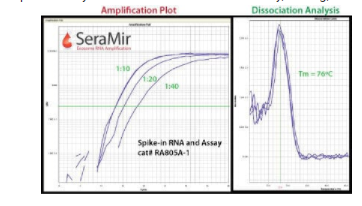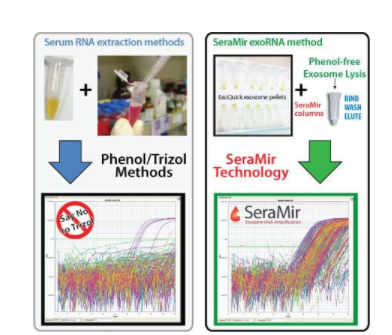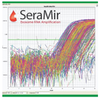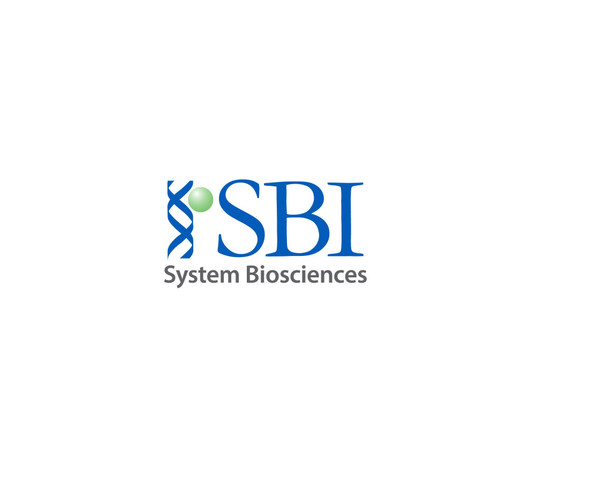System Biosciences
SeraMir Exosome RNA Amplification kit from Media and Urine (10ml ExoQuick-TC and 10 exoRNA columns)
- SKU:
- RA800TC-1
- Availability:
- Usually Shipped in 5 Working Days
- Size:
- 10 reactions
- Shipping Temperature:
- Blue Ice
Description
SeraMir Exosome RNA Amplification kit from Media and Urine (10ml ExoQuick-TC and 10 exoRNA columns). Cat# RA800TC. Supplier: SBI System Biosciences

Overview

With cargo that reflects the makeup of their parent cells and their easy isolation, researchers are increasingly turning to exosomes as a source of disease-related biomarkers. To simplify and standardize the isolation of RNA from exosomes, SBI has developed the SeraMir family of products.
The SeraMir Exosome RNA Purification Kit for Media & Urine includes everything you need for optimized isolation of exosomal RNAs from most biofluids—ExoQuick for fast and efficient exosome isolation and a phenol-free lysis buffer and rapid spin columns to extract RNA from your isolated exosomes.
Choose the SeraMir Kit that’s right for youHow It Works
Go from sample to amplified exoRNAs in a single day
- Isolate exosomes from patient biofluids with the included ExoQuick-TC reagent
- Purify exoRNAs with SeraMir columns (also included
Purified exoRNAs are fully compatible with most downstream applications, such as qPCR, microarray analysis, or NGS.
Isolate serum exosomes and purify exoRNAs

Tail exoRNAs and synthesize double-tagged cDNA

Use the SeraMir spike-in RNA control in a qPCR assay to control for exoRNA recovery, tailing, and cDNA synthesis.

Supporting Data
Better qPCR profiling with SeraMir

Figure 1. Serum RNA prepared by the SeraMir Kit delivers more reliable, reproducible qPCR profiles than when the RNA is isolated using conventional Trizol methods. Profiling of 380 Human microRNAs across the SeraMir 384 Profiler. The phenol-free exosome lysis step coupled to the small RNA binding columns isolates exoRNAs with much higher purity than Trizol/Phenol based methods. The SeraMir exoRNAs are compatible with downstream polyadenylation and reverse trancription reactions for amplification and accurate qPCR profiling.

Figure 2. Serum exoRNAs prepared using SeraMir deliver excellent performance in microarray studies.
Samples from a pooled normal serum preparation and from a male caucasian (age 73) with adenocarcinoma of the colon were used in this study. Exosomes were precipitated from 250 µL of serum using the SeraMir Exosome RNA Amplification Kit. The T7-amplified “sense” exoRNAs were then used for direct labeling analyses on LC Sciences miRBase ver.16 array chips (performed in triplicate).
The exoRNAs were hybridized across 1,214 different microRNAs on the probe set. Of the 1,214 microRNAs analyzed, 79 microRNAs showed a signal intensity >32. Within this set of 79, there was a clear colon versus normal “signature set” of 40 microRNAs that could discriminate normal from colon cancer serum samples with a p-value < 0.01. The identities of the microRNAs found in this study have been masked while further investigation continues.
2 Reviews
-
Review of Urine Use
This kit made exosome and RNA isolation from urine samples straightforward and efficient. The results were consistent, and the RNA quality was excellent. It works seamlessly even with small sample volumes, ensuring minimal waste. Great for clinical studies!
-
Review of Media use
The ExoQuick-TC and exoRNA columns kit is a game-changer for exosome isolation from cell culture media. It's quick, reliable, and yields high-quality RNA for downstream applications. The protocol is easy to follow, making it suitable for both experienced researchers and beginners. Highly recommend for EV research!













